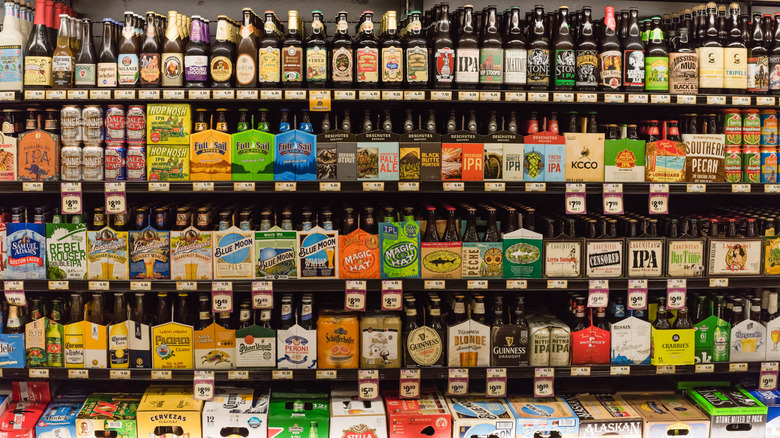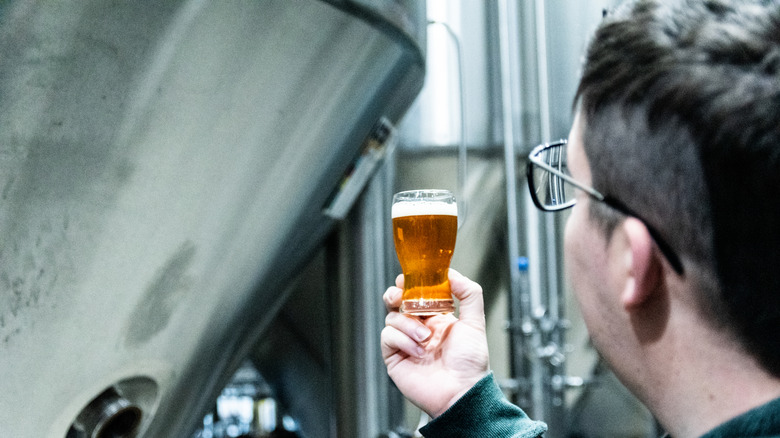The IPA Beer Rules You Should Never Break In The Grocery Store
While it's best to head to a local craft brewery to get some expert IPA recommendations, what do you do when you want to buy a pack from the store? Are there rules you should follow when buying IPAs from a supermarket? To get some insight, Chowhound had an exclusive chat with Rich Higgins (@maltyrich on Instagram), Master Cicerone, certified sommelier, and former brewmaster.
According to Higgins, you should avoid buying beers that has been exposed to excessive light. "When light (including LED, fluorescent, incandescent, and sunlight) shines on beer, it irradiates hop bittering compounds and breaks off an aromatic molecule that's also in skunk spray," he warns. Simply put, some beers left to languish in light will start to taste skunky. This makes light a dangerous element for lots of different beers, but especially IPAs. Usually, the more bitter the beer, the higher the hop content, and the more sensitive to light exposure. The 3-methyl-2-butene-1-thiol compound affected by light also happens to give IPAs their characteristically bitter flavors. "So IPAs are like vampires — they're terrified of light," Higgins says.
So opt for IPAs in cans, kegs, or brown glass, and avoid those packaged in clear or green bottles. "Brown glass blocks 98% of the light wavelengths that damage beer, green glass only blocks 20%, and colorless glass doesn't block any," Higgins says.
Temperature matters for IPAs too
When buying a new package of IPAs, the temperature of the storage area matters just as much as the amount of light exposure. Warmer temperatures speed up oxidation, so it's best to buy beer that's been kept in a beer fridge or similarly cold environment. "If you prefer your IPA to sport flavors of tangerine and mango rather than a skunk in a shoebox, store your beer cold, drink it fresh, and keep it away from light," Rich Higgins suggests. The signature aroma of hops, which can vary from refreshing notes of pine to sweet fruits, doesn't stick around forever and will fade faster in warmer temperatures. "If you store your IPA cold, that'll slow down their degradation," he says.
Kept cold, Higgins says a typical IPA should be good to drink for months after leaving the brewery. And if you don't have the fridge space, don't panic. "Even the bottom shelf of a cool closet is better than out on your kitchen counter," he notes. Still, if you see a box of IPAs stacked in a grocery store aisle, be wary. It might seem like a small issue, but it could have lasting effects. "Stored at room temp, that IPA could have noticeably less hop aroma and bitterness in just six weeks," Higgins says. Once you've bought your IPA of choice, the rules don't stop there, and Higgins has a few suggestions to ensure you get the best drinking experience.
These rules still apply after a purchase
Just as light and temperature can affect IPAs sitting unopened at the grocery store and at home, these factors impact flavor once you've cracked a cold one, too. "To fully enjoy all the good fruity, floral aromas in an IPA, you should pour it into a glass rather than drink from a can or bottle," Rich Higgins says. This elevates the aesthetic and mouthfeel of an IPA, but don't just sip without following this final rule: Keep the glass out of the sun. "On a sunny day, I notice my beer starting to skunk in as little as 10 minutes. Day drinking on a bar patio, I'm the weirdo using the menu or my wife's purse to shield my beer from the sun," he shares. This applies in particular to smaller IPA brands, but for big names, don't worry too much. "A handful of big industrial lagers are bittered with hop products that are un-skunkable, so even a full day in the sun won't turn those beers skunky," he notes.
For a quality IPA experience, follow these rules, because once your beer is lightstruck, you can't go back. "Those skunky, aromatic thiols are in there for good," Higgins says. If your IPA does end up spoiled, there are ways to use skunked beer, but beer and light still aren't a good mix. So don't leave a brew out in the sun, and avoid buying light-vulnerable IPAs stored under grocery store fluorescents.


